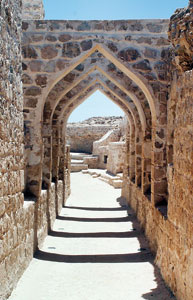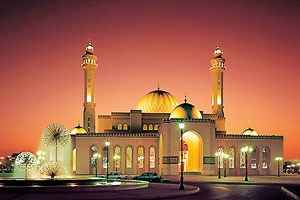Historically, the world's best pearls came from the Persian Gulf, especially around what is now known as Bahrain. The secret of the special lustre of Gulf pearls is probably due to the unique mixture of sweet and salt water around the island. Today, pearl diving is practised only as a hobby, although Bahrain remains one of the foremost trading centres internationally for high quality pearls. In fact, cultured pearls are banned in the Bahrain pearl market, in an effort to preserve the location's heritage.
 |
| Bahrain Fort |
I have been living in Bahrain for over a year and I find it one of the best countries to live in the Gulf Cooperation Countries (GCC). It's not Dubai, but it has more soul than Dubai and will probably be the next Dubai. It is still a small community but investments are pouring in.
Unlike any other GCC country it has a rich cultural heritage including several UNESCO recognized sites If you do visit Bahrain in transit and have a day or two for sightseeing make sure you visit the following locations.
Qal'at al-Bahrain
This is an archaeological site surrounded by palm groves. Excavations at the site were started about 50 years ago by a Danish expedition.
The French took over work till the late 70s and since 1987 work was carried out by archaeologists from Bahrain. This site was once an important port city, where people from different parts of the world engaged in commercial activities. It was the capital of one of the most important ancient civilizations of the region - the Dilmun civilization.
A coastal fortress that was probably not built before the 3rd century AD was excavated in the northern part of this site. It is believed that some of its building materials were later reused for the construction of a large medieval fortress.
Arad Fort
 |
| The Grand Mosque |
Built in the 17th century Arad Fort, has undergone extensive restoration. Today it is illuminated at night, presenting a magnificent sight.
Built by the Portuguese in 1522, on the ruins of an earlier smaller fort built by the Bahranis, the fort has great historical importance in the Arabian Gulf region. Excavations have revealed soldiers' barracks and horse stables.
Bab Al Bahrain
A traditional souq, Bab Al Bahrain is one of the busiest places in Manama, the capital of Bahrain. The souq, located in the heart of the capital, has shops that sell all kinds of everything from clothing and footwear to gold, sweets and spices . When you get tired of shopping, you can always enjoy a hot cup of tea or coffee or a variety of local drinks and snacks.
Bahrain International Circuit
The second longest track designed specifically for Formula One, the Bahrain International Circuit has been in use since 2004. The circuit is the second-longest track used in the series, next to the Spa-Francorchamps track in Belgium, which is seven kilometres.
Bait Al-Quran
Situated in the capital Manama, this is believed to be one of the most renowned Islamic museums in the world. The museum presents a unique historical collection of copies of the Quran, in different styles of writing from around the world from China to Andalus (Spain).
 |
| The Tree of Life |
The museum comprises a mosque, a Quranic school and exhibition halls. It has been designed to traditional Islamic architecture but with modern touches.
The museum is divided into five sections and has an open court with a fountain, where a traditionally-designed minaret that goes back to the 12th century takes pride of place.
Ain Umm Al Sejoor
This natural water spring was discovered in the village of Duraz during an excavation of a Dilmun-age temple in the early 1950's. Two sculpted lambs that were found near the spring, were an indication of the sacred nature of the water well.
Al-Faith Fort
Built during the reign of Shaikh Salman Bin Ahmed in 1852, the fort has a high vantage point overlooking the desert. The fort has four towers, two square shaped and the other two circular. It is believed that the Al-Faith Fort was built on the ruins of an earlier 1698 castle.
Al Khamis Mosque
This is one of the oldest ruins of the Islam region, with the foundation believed to have been laid as early as 692AD. An inscription found on the site, however, suggests a later foundation date during the 11th Century.
The Tree of Life
This mystery tree that has survived in the middle of the desert with no known water resource is believed to be about 400 years old. The tree belongs to the Acacia family, which usually has a life expectancy of less than 100 years. |




